#niflheimr
Explore tagged Tumblr posts
Photo
@raven-6-10
It comes very close to what I have been picturing in my mind. One shoulder was always left bare, but it's a definitve yes to the long skirts and the colours.










JJ Valaya Couture Collection 2020
4K notes
·
View notes
Text
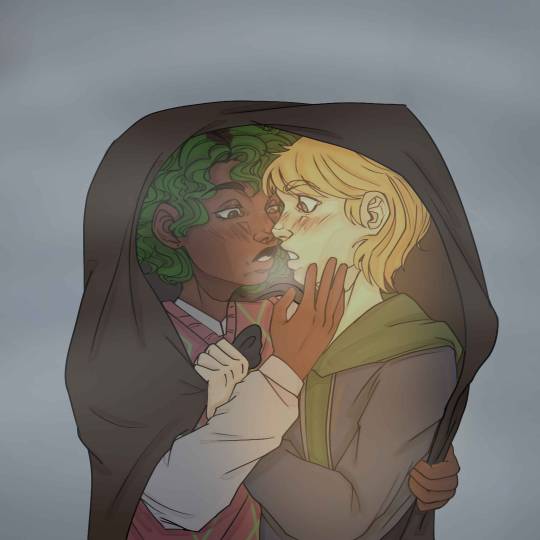
What if we kissed during a Niflheimr snowstorm to keep us alive just a bit longer?
#magnus chase and the gods of asgard#magnus chase#alex fierro#fierrochase#art#drawing#pjo#the ship of the dead
128 notes
·
View notes
Text

niflheimr
11 notes
·
View notes
Text
WIP word game
Thanks to @bottan-blobbington for the tag! I'm very much a one-thing-at-a-time kind of person (that, and Konungsskapari is such a big project I have no brain space for anything else) buuuut since it's kind of like a hybrid between a multi-chapter fic and a collection of oneshots, it still counts, right? 😄 let's see if I can get one for every remaining chapter...
The game: you will be given a word. Then you share one sentence/excerpt from your wip(s) that starts with each letter of your word.
My word is: ANTICS
__________________
A
As for its occupant, Thor had never seen one of the Jötnar up close before. Angrboða's sapphire skin was covered in swirling scars. She was clad from the waist down in a skirt made of furred hide, leaving her chest bare but for the bandages around her left shoulder. Her long dark hair was braided with amber in a snake that fell almost to her ankles, her horns long and curved, scarlet eyes glowing with hidden fire. Her features were like those of no man or woman Thor had ever met, and yet somehow resembled both at the same time. Thor could not decide if he found her beautiful or monstrous.
(Jötunheimr)
N
"Norns, you should see your face! Forgive me, Silvertongue. It is an old joke amongst the dead." He clapped a hand on Loki’s shoulder and they started to walk once more. "I do not know how to describe it. It is as if someone has placed a hook beneath my ribs and is slowly reeling me in. I cannot escape the feeling."
Loki chewed at his lip. He knew that feeling all too well. It had kept him trailing after Thor for their entire lives.
(Niflheimr)
T
They passed a cluster of stinking orange rocks, each one several feet in length. Thor kicked at one idly, recoiling when his boot sank into its spongy flank. Loki let out a barking laugh.
"What?" Thor growled. He poked the rock with Mjölnir's haft, and the stench was enough to make his eyes water. "What do you think this is? We've passed quite a many clusters like this."
Loki laughed again, fighting back a cough. "That would be its scat." When Thor shot him a puzzled look, Loki stiffled a giggle. "Shit, Thor. You're desecrating your hammer with the shit of a thousand-foot-long fire dragon."
(Muspelheimr)
I
"It seems the pickled herrings are calling me, brother," he said, turning to face the palace. "Please, lead the way."
Loki's expression switched to something wicked, the kind that Thor knew and loved so well. The kind that always meant trouble. "I'm not kissing you if your breath stinks of rotting fish," he said tartly. "Besides, you have more important matters to attend to than herrings, I think."
(Epilogue)
C
Cool fingers brushed over Thor’s wrist, startling him from his thoughts. Thor looked over sharply to see Loki, a knife already concealed in one hand, his eyes shining with fierce determination. Gold glittered in his dark hair. Thor set his jaw.
(Asgard II)
S
"Stop!" Thor interrupted, circling his fingers around his brother’s wrist. He'd wanted his hair cut, yes, but this was another matter entirely. "Wait, I'm not sure I want that-"
"You can't just have this hanging here from your temple like some kind of worm," Loki derided, waggling the braid between his fingers. "That would be a surefire way to ruin anyone’s perception of Asgardian fashion for the next thousand years."
(Svartálfheimr)
______________
I see my writing moots are mostly already tagged, but maybe @nachttraum has something to share? (No pressure ofc!) Or if this happens to pop up on someone's dash: the word is FROST 😄
11 notes
·
View notes
Text
@a-world-in-grey
Right, after some deep diving through FFXV wiki and some research into hereditary titles, inheritance laws and various historical and fictional courts, I think I have a general idea of what I want the Niflheimr court in general and the Aldercapt dynasty in particular to look like.
***
Let's start with the inheritance laws.
I settled on agnatic-cognatic (male-preference) primogeniture i.e. the throne goes to the eldest son, then his brothers by order of age, then his eldest sister and so on. And since the Aldercapts don't have Bahamut artificially pruning the family tree to one child per generation in recent centuries, there are actually people related to the Emperor with a legitimate claim to the throne.
(Side-note: some pruning is still happening as a result of children competing for the throne. Iedolas' brothers and one sister had died before he even came to the throne.)
The issue here is that Iedolas is an ambitious man - even if he's not obsessed with reviving Solheim (at the moment) - and wants to leave a legacy. Which means he wants his heir to be his child/grandchild.
You raised a valid point about Iedolas having children before that point. Which. Uhmm. Canon doesn't exactly help here. The only thing we know for certain is that he had at least one son (b. 720 ME) who died at the earliest in 748 ME (because that's the birth year for Solara Antiquum) but was definitely dead when the game kicked off in 756 ME. Considering Iedolas is from Mors' generation that's kind of late to have your first child.
So!
I'm gonna make an executive decision here.
Iedolas did have children before that with his wife. Specifically two sons and a daughter. Possibly some grandchildren even. However they all died due to combination of illnesses, accidents and deliberate action. At that point he tried for another child with his wife, which canonically ended up with her death from childbirth complications within a year. In this au, the son in question was born early - resulting in underdeveloped lungs plus host of other health issues - and died as a young teenager due to pneumonia.
Hence, the order for Besithia to create an heir for him.
***
Situation at the Imperial court is surprisingly stable at the moment.
Just because the Emperor has no children doesn't mean he has no heirs*. The current heir presumptive is his younger sister but since she's rather elderly, the throne is actually probably going to be inherited by his great-niece. The woman in question is from a high-ranking house, married to a man from similarly titled house, has a range of useful political and military connections and a daughter of her own at the time of Prompto's birth.
(Iedolas had been planning to betroth Prompto to his great-great-niece and name the mother a regent just in case he dies before his son is an adult.)
So most of the politicking is currently about getting into the good graces of the imperial heiress and discrediting the rivals. The most opposition is from warmongers (Ulldor) as she's much less militant than the current emperor, so will likely focus on consolidating the imperial gains in Tenebrae and addressing social issues instead of continuing the conquest.
***
As for where that would leave Prompto (or whatever Iedolas would rename him)?
I'm headcanoning that Niflheimr royals don't introduce their kids to public until they are at least 10. Before that there might be rumours, especially if the Empress is obviously pregnant, but nobody will confirm anything outright.
There's a bunch of historical reasons behind that, but mostly it's very useful if you need to, erm, adjust the family tree.
And right now it means that Aldercapt still has time to get his kid back instead of writing him off as a lost cause and trying again or just formally declaring a new heir from among his relatives. Because nobody will bat an eyelash on the boy not being seen before his formal introduction.
If the Nifs actually recover him, he will be raised in a secluded estate on the outskirts of Gralea with staff being responsible for his upbringing and Iedolas visiting often to check on him.
***
*I was inspired by the House Arryn. Somebody once joked that even if you are five generations removed from lordship, you can still end up being the Heir Arryn. A peasant sneezes in the Vale and they've lost half their house members.
#maybe possibly prompto was made from the late empress dna#and there are no samples left anymore#another reason for aldercapt to want him back#my ideas#ffxv#niflheim prince au#niflheim#iedolas aldercapt#fic ideas#fanfiction
20 notes
·
View notes
Text

NIFLHEIM | NIFLHEIMR | WORLD OF MIST + GINNUNGAGAP 🌫
Big Print version of a panel I made for Verses of the Nine Worlds by Nico Solheim-Davidson. The poems in it are Homeric and Orphic-inspired; so the panels represent the Nine Realms of Norse cosmo/mythology in a style inspired by Greek red/black-figure ceramics, Viking Age knotwork and petroglyphs. Prints of these panels are available in my $hops (with free US shipping!)
ETSY | KO-FI
#niflheim#ginnungagap#norse pagan#heathenry#paganblr#heathen#norse paganism#pagan#norse mythology#auðumbla#norse gods#norse heathen#norse deities#norse polytheism#altar decor#germanic paganism#paganism#pagan artist
8 notes
·
View notes
Text
POV: all your teammates are autistic
–Okay, can anyone fill me in, I know, like, none of what’s going on.
–The caldera is the region of the universe where most fire-filled worlds are.
–The elements are not equally distributed across the universe, some of them concentrate in certain places. The core of the caldera has naught but fire, no solid ground to walk on, not even air to breathe, nothing but heat in its purest form.
[???] Slides their chair towards [doctor] and leans their head to her to say:
–It’s plasma.
And slides back to the control panels.
–The mantle of the caldera has worlds hot enough so iron is always liquid, few things can remain solid in such environments, but there are thick clouds of everlasting thunderstorms.
–Excellent for me. –Says the elemental.
–Most inhabited caldera worlds are in the– crust- of the caldera, where it’s still hot but- m- manageable for some people.
They receive a sudden burst of excitement:
–Ooh! My favourite part about it is the one cold-dominant world which somehow exists touching the caldera and casts a heat shadow into the worlds behind it. It is traditionally called Niflheimr, but the natives call it Gelaria.
–Or Nuaimut. –Completes Murial.
–Okay, that is… A lot. Of information, thank you. I think I absorbed maybe a quarter of it.
2 notes
·
View notes
Text
Pick Me Up Infinite Gacha
Okay, I caught up the novel translation. Soo...it's 208/327 for the main story. 119 chapters left.
So far, this novel still one of my favorite. It's really well written. The story line, plot, characters development, world. I can say this is my favorite Korean webnovel after ORV.
About Han Seojin, a famous ranker in game Pick Me Up, a game about heroes who climbing tower to save the world. One day, when he playing the game, his heroes encountered an unidentified enemy. Suddenly he lost unconsciousness and when he woke up, he was inside the game, as an hero in a newbie account. He always think his heroes in this game have their own personality, like a real human. It's turned out they ARE human being from different dimensions.
The unique things about Pick Me Up are each account has different heroes and quests, and when your hero dies, they cannot revived. Due the random summoned heroes and difficulties, Han always says this game is based on luck. Also, the heroes can suggest something to the master.
The competent Master now being a hero with newbie Master. He must do his best to clearing the quests.
.
.
I love the strict but not really heartless Han. He's really smart, can be cruel if he need, but also kind inside. He's getting being psychopath though lol. The mad dog. Anyway, I repeat it again: he isn't heartless but can be cruel if needed. I'd like to see him meet his first hero.
Jenna also my favorite. The cheerful genius archer. She really mood makers.
Aaron definitely my most favorite character, beside of Han. He didn't give up despite his lack of talent. Reminds me of Rock Lee. And I love his timid personality. I'm waiting for his return. I wonder how much his personality will change.
Eolka, Edis, Dika, Velkist, Neryssa, Rodrick, etc. And Niflheimr's first party. And of course Anytng. I love almost all of the characters.
I really recommend you this series if you love smart MC, games with strategies, strong characters, and complex story. The manhwa also really good! As a novel reader, I would say the manhwa so satisfying to read!

Now since I caught up PMU, I think I'm gonna continuing read EX Rank, then TCF.
#pick me up infinite gacha#webnovel recommendation#korean webnovel#han islat#manhwa recommendation#Han seojin
8 notes
·
View notes
Note
something i find interesting, it was a blink and you miss it moment in brotherhood, in the "bittersweet"/ignis episode, basically stating that the war ended 30 years ago and that the crown sort of "regulates" the news/what's shown, i find that fascinating, what are your thoughts on it?
Hi, Anon!
Okay, disclaimer here: While I saw Brotherhood twice, it's been a few years. I forgot quite a few details. So I can't quite remember the context the information was presented in. But since you've asked for my thoughts, it's the context is not too important.
I personally think that the war wasn't "over" in the last 30 years. I imagine it having been more of a cold war between Niflheim and Lucis because Niflheim didn't have the means yet to invade Lucis and hold the territories they conquered.
Instead Niflheim concentrated on the nations it could reach. I.e. Tenebrae and Accordo. Much of Tenebrae has been under Niflheimr stewardship for close to a 100 years now, if I remember the information correctly. By the time Regis brought Noctis to see the Fleurets, only Fenestala Manour and the surrounding area was still autonomous.
And Niflheim conquered Galahd in that time.
One could also make an argument for the war being "over" meaning that Lucis basicall capitulated 30 years ago and doesn't want to admit it to the public. But that angle doesn't feel quite right.
So, in my opinion, it's, like I said, more of a cold war situation.
And, when it comes to war, every nation "regulates" what the public sees. That is nothing new. You want to keep people from panicking and keep fighting morale as high as possible. Which means you keep negative news as quiet as possible, try to twist it into a 'that's good actually' narrative and hype up the positive things. Classic propaganda.
Or, what I think the crown is more guilty of: keeping news of the war's progress in general as quiet as possible. I honestly believe that many Insomnians don't know how the war is going, and where the frontline is. They just know the war is going. Which is, I feel, an aspect of why Regis's decision to sign the 'peace treaty' (it's a capitulation, le's be honest) was met with quite a few protests. People just didn't know how badly Lucis was actually faring in the war.
Oh, I just had a thought. Could people think, because of which information is being presented by the Crown, that the war has been over for 30 years already?
That would be... something. I mean, you can lie to a city full of people who never leave it. Which also sheds light on another angle of the refugee situation.
According to the information the Insomnians have, these people showed up without any real reason (the war is over, it cannot be that bad) and are now mooching off of them.
This feels like material for another au.
#ask#anonymous#ffxv#lucis#niflheim#in war every nation does propaganda#and regulates informations#that's not surprising#they could also deny the war#there is no war in ba sing se#that type of deal#this is interesting to think about#geist answers
12 notes
·
View notes
Text
Solitary Confinement
Nyx paced the length of the small, windowless room they tossed him in for the one hundred twenty eighth time. It wasn’t any bigger than a storage room back in the Citadel, just big enough for a tiny commode with sink and still have room to lie down. It made him miss his dingy apartment back in Little Galahd.
Well, that and it drove home the knowledge that he was a prisoner. The few people he’d seen didn’t have uniforms, but they spoke Niflheimr, so it must be the Niffs. Nothing else made sense.
He really hoped Pelna had gotten away. He hadn’t seen him in the time he’d been here, so he was choosing to take that as a good sign.
He hadn’t seen anyone since they’d thrown him in here however long ago.
One minute, Pelna was teasing him about date night with Cor, the next a drop ship and two squads of MTs dropped down on their heads. Nothing the two of them couldn’t handle, generally speaking. Except the sun had gone down faster than expected, and two Iron Giants popped up in the middle of the fight.
Nyx had pushed Pelna out of the way and yelled at him to go. He saw the flash of a warp and then the Iron Giant threw him into a MT that took that moment to explode. His armor took most of the blast, as he discovered when he woke up and found himself in more or less one piece. Which was great news right up until he realized he was tied to a chair.
They asked the usual questions about who he was and what he was doing in their accented Lucian. He answered back in Galahdan insults, which were always more satisfying than Lucian ones. The expected backhand dazed him, and when he could pay attention again, he heard them dictating terms and realized there was a camera in the room.
He’d yelled insults again, but they ignored him. Just hauled him up and dragged him to this room, throwing him in before slamming the door shut. He’d caught a few sentences of Niflheimr as the door clanged closed, but not enough to make sense of what they’d said. And that was the last he’d heard of anyone.
He really hoped Cor never saw that video they were making. Lucis couldn’t compromise their security for one glaive, not even one currently dating the Marshal. It would only upset Cor to see Nyx in this situation when he couldn’t do anything about it, and Nyx didn’t want that. He’d always understood and respected Cor’s devotion to Regis and Lucis, and that personal concerns were secondary to duty.
He’d never wanted to hurt Cor. But it seemed like this time he couldn’t help it. Even if Cor didn’t watch the video himself, someone would tell him of it.
Just, maybe if they didn’t let Cor see it, see him like it, it wouldn’t be as bad.
If only someone would come in, try to interrogate him. He’d even take the usual ‘friendly getting to know you’ beating. Anything other than this damn nothing. The lack of information was driving him up the wall as much as the situation itself.
With no windows, there was no way to reliably measure time. He’d gotten thirsty enough to drink out of the small sink and use the commode a couple times. He’d laid down and tried to catch a few hours of sleep a few times. Once, he’d woken up to a half dozen packs of rations someone had thrown in while he’d been asleep.
All he could say is that it had probably been more than a couple of days he’d been stuck here, and he didn’t know why they were ignoring him. He’d think they’d forgotten about him if it hadn’t been for the rations. What was their game?
He wished desperately for an actual enemy to fight, instead just the voices in his head. How much longer could this go on?
#febuwhump#febuwhumpday2#solitary confinement#fic#nyx ulric#kingsglaive#nyx has a bad time#sequel to day 1
10 notes
·
View notes
Text
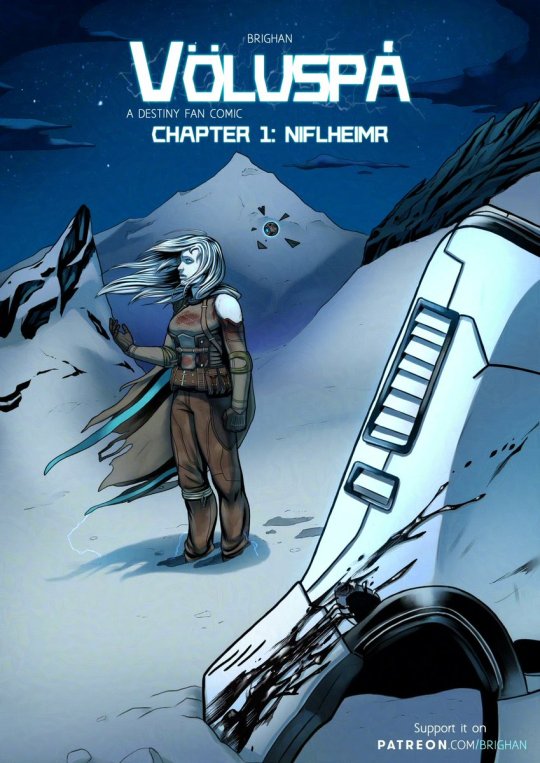
VÖLUSPÁ - CHAPTER 1: NIFLHEIMR
Wielding the Light.
Posting pages every Sunday, 4pm CEST on: Twitter | Tapas | Faneo (spanish)
>Read the Prologue here<
Support it with Early Access Ko-Fi | Patreon
#destiny 2 art#destiny art#webcomic#völuspá#vex#comic#oc#valeria#brighanart#hunter#vex harpy#edz#awoken#earth#cabal#>:3c#feeling normal about this chapter's pages
37 notes
·
View notes
Photo
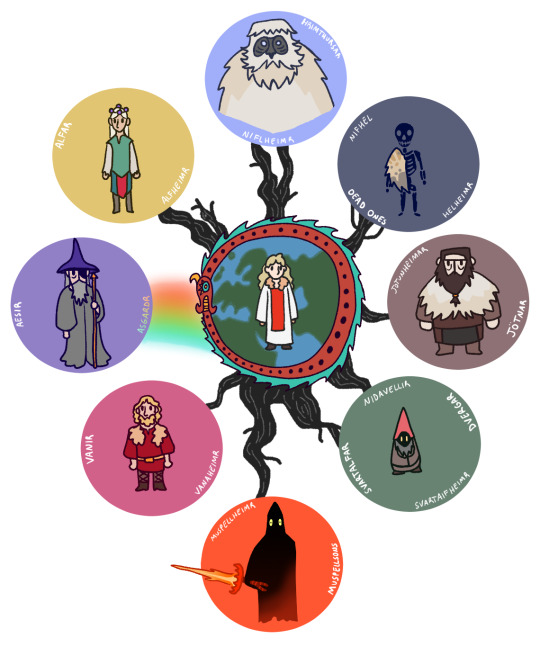
The conventional description of the Nine Realms. Each is a different branch of Yggdrasil, separate from the others.
Watching the newest Overly Sarcastic Production video on the mythological Nine Realms (here) has motivated me to return to writing a proper myth stuff entry. This is going to be on a single topic and a widespread misconception.
We in the modern world have a bit of a handicap when it comes to understanding the old world. The culmination of science and historical knowledge makes it difficult to understand people who don’t have that same basis of information informing their own beliefs. The most important widely known fact for our purposes here is astronomical. When most people today hear the word ‘world’, the next mental connection is often ‘planet’. We know we live on a planet which itself is one of many in a great celestial system of stars. This is the reason why there’s such a mental disconnect between us and the concept of the mythological ‘realm’.
This cosmological bias is evident in adaptations of Norse mythology: in Marvel the Nine Realms are different planets and in both God of War and Magnus Chase the Nine Realms are different dimensions. The other eight are connected to our own planet or dimension. It goes without saying that the medieval Norse and their ancestors did not know what planets or dimensions were. If they couldn’t understand the Nine Realms as dimensions or planets, what did they imagine them as?
Let’s look at the language. ‘Realm’ is but one translation for the word ‘heimr’. When we say Nine Realms in English, the Norse said Niu Heimar (heimar being the plural of heimr). The same word is used as a suffix for most of the commonly listed ‘realms’: Vanaheimr, Alfheimr, Niflheimr, etc. This word was not exclusive to mythology, however. One of Norway’s largest cities, Trondheim, bears this as well. “The Realm of Trond” doesn’t quite ring though. The more direct translation is “the home of the Trønd”, which makes more sense when you know that the trønder (þrǿndr in Old Norse) were a people who founded the city which bore their name. Applying this to the mythological names we get ‘home of the Vanir’, ‘home of the Elves/Alfar’, and ‘home of Mist’. When you read it outloud and abandon the astronomical point of view for a medieval geographic one, these names read less like planets and dimensions and more like countries or territories.

A rough attempt at combining the disparate geographic elements in the Eddas into a single plane. Jormungandr not included. Although, his presence makes one wonder if the Norse had an idea like the Greek Oceanus, where the mortal world was surrounded completely by a continuous river.
In this context, the confusing geography of the mythological heimar makes (a little) more sense. The Norse understood the mythological races not as living in a magical otherworld, but as living in far-off lands and territories. Jotunheimr’s frequent pluralization makes more sense in this regard: the jotnar are not a monolith, so of course there are multiple territories controlled by different populations of giants. The multiple ‘realms’ of the gods in Asgard are recontextualized as separate counties or neighborhoods controlled by the head gods. The Old Norse, after all, were a feudal society where farmers controlled large plots of land. The second suffix found in the mythological realms adds to this: ‘gardr’ means a fence or wall, which is what farmers would encircle their land with to demarcate boundaries.
The surprising amount of physical geography that pops up also makes more sense. Skirnir, the vassal of Freyr (note the medieval feudal term), must pass “wet mountains” to reach Gerth in Gymir’s abode. Griminsmal mentions many, many rivers that cross the lands of the gods
It isn’t all peachy-keen. The names we like to focus on so much are still poetic inventions. It’s doubtful that the skalds and priests who recited and/or believed in them put as much thought as anyone today into their mechanics. There are also still supernatural elements surrounding them, as can be found in other myths and legends: the home of the dead cannot just be crossed like any old border, and all the Jotunheimar are East of Asgardr and Midgardr regardless of position. Hel itself is a conundrum as it is said to be both beneath the earth and accessible by crossing the earth. The primordial Niflheimr and Muspelheimr are said to be north and south respectively, but that’s it.
Still, the idea of these mythological polities as planets or dimensions continually hinders modern understanding and writing concerning them. Looking at things from the medieval point of view rather than the modern one can shake up the preconceptions we continually apply to these fantastical lands.
Sources:
“Contradictory cosmology in old norse myth and religion – but still a system?” by Eldar Heide (2014)
“Eddic Mythology” by John Arnott MacCulloch (1930)
#myth stuff#norse mythology#germanic mythology#nine realms#the nine realms#niu heimar#yggdrasil#mythology#jotun#jotnar
22 notes
·
View notes
Note
Hey hey hey!!! New chapter dropped for pick me up
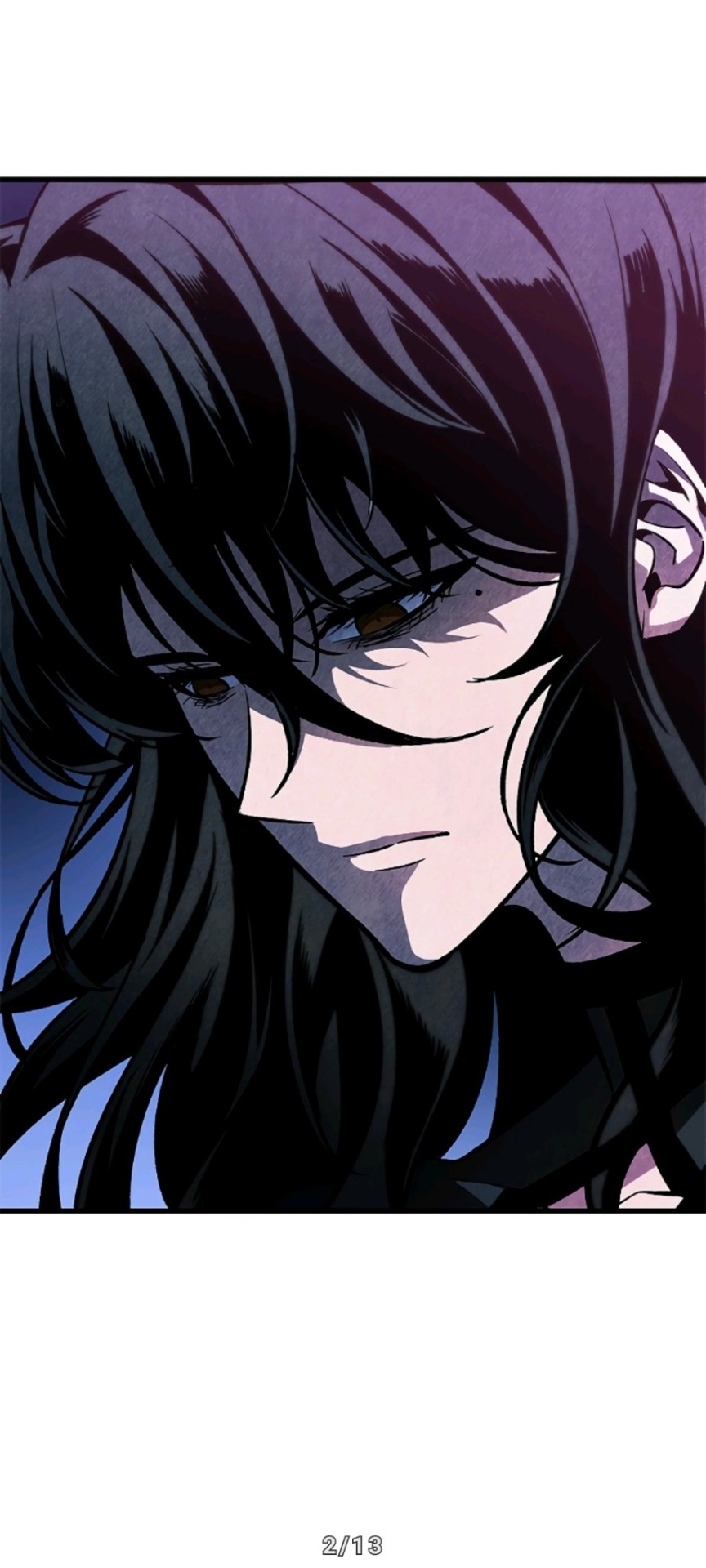
Ahhhhh!!!!! She's so distraught!

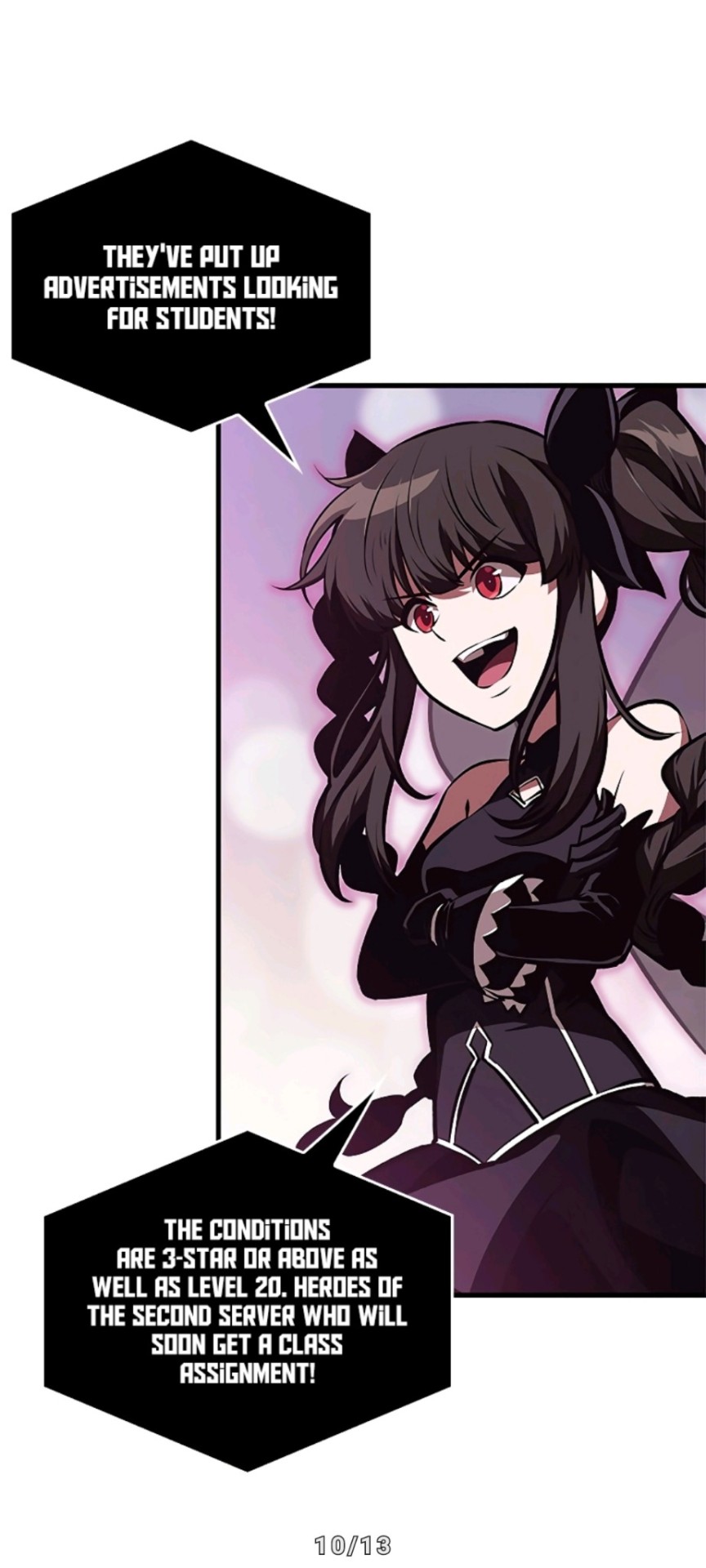
Ooooo~ we're getting more info on Niflheimr
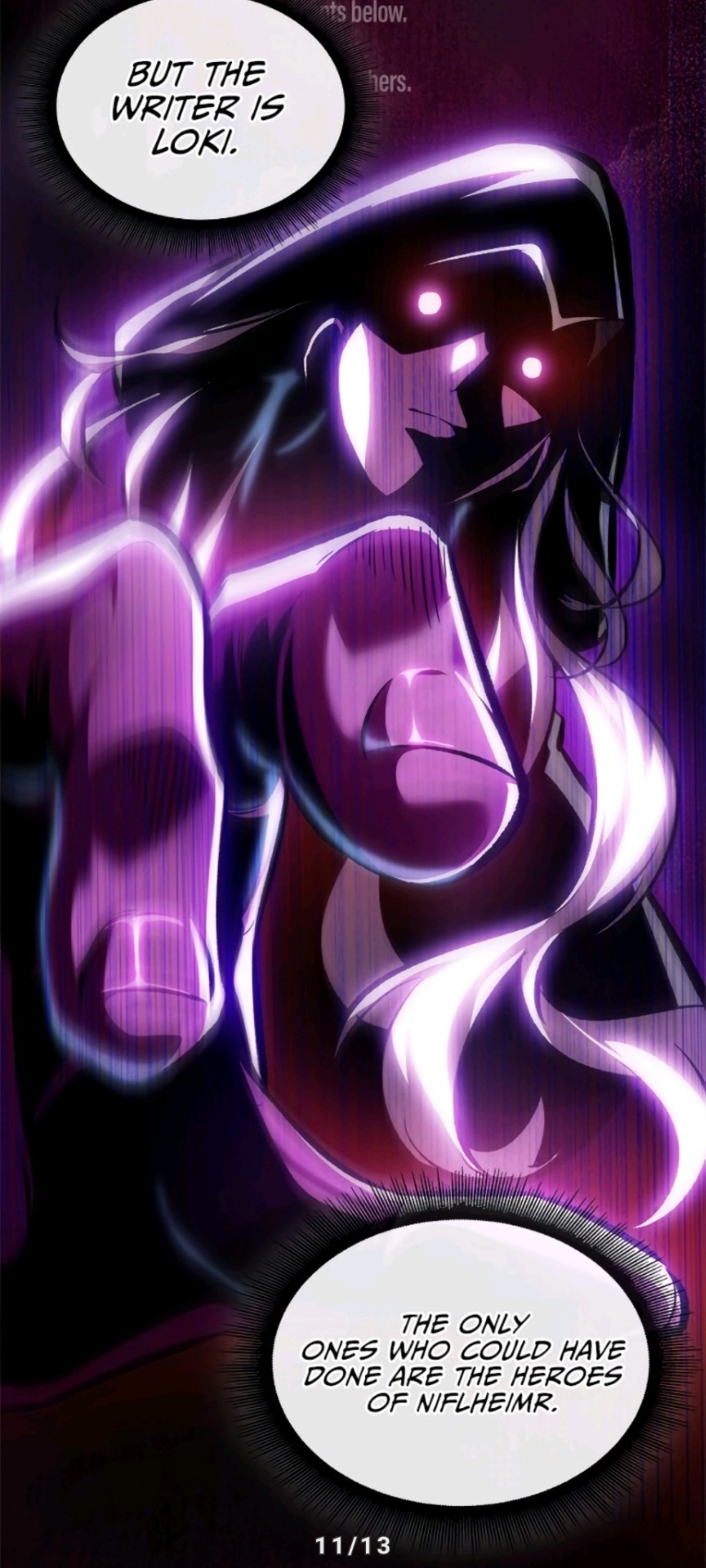
Oh damn.
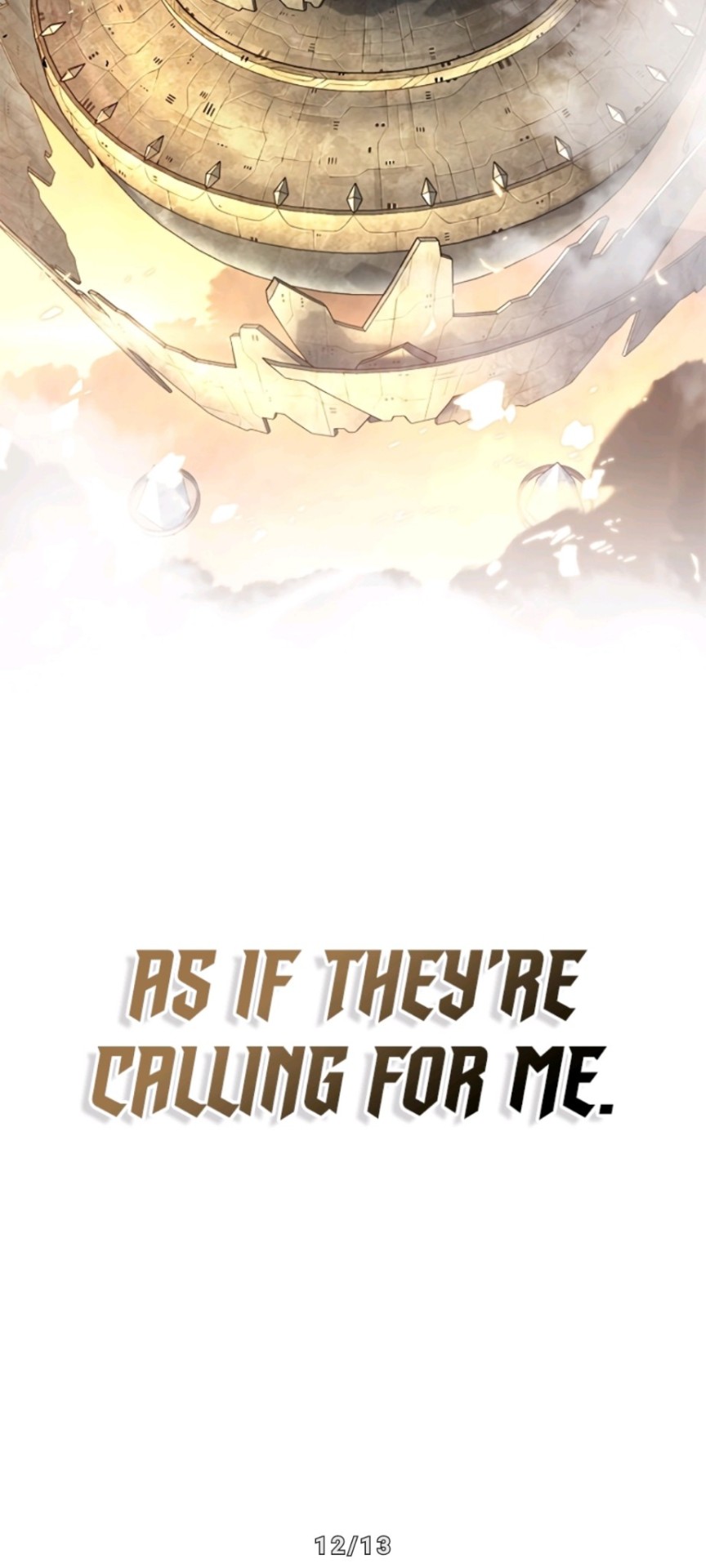
I'm excited for the eventual reunion!
Same. . . I'm still so sorry for Edis 😢
Usher is the first person I've seen her grieve. I guess it's clear that they've been very close off-screen. And Aaron? He was crying!
YES!!! NILFHEIMR!!!!
I'm so looking forward to Han's reunion with the heroes, considering we've seen two of them in the beginning, so I think the search is almost over!
3 notes
·
View notes
Text
Chapter 1: Mediterranean



Level 1: The Path To Avalon Level 2: Niflheim Level 3: The Norse Connection Level 4: God Of Thunder Level 5: Realm Of The Dead
Screenshots
Lara is investigating a sunken island in the Mediterranean Sea as part of her search for Avalon, hoping it will lead her to an explanation for the disappearance of her mother Amelia and salvage her father Richard's academic reputation despite the skepticism of Zip and her research assistant Alister.
History & Archaeology



KRAKEN: The kraken (/ˈkrɑːkən/) is a legendary sea monster of gigantic size and cephalopod-like appearance in Scandinavian folklore. According to the Norse sagas, the kraken dwells off the coasts of Norway and Greenland and terrorizes nearby sailors.
Learn more
This creature appears as an obstacle/enemy.
NEFLHEIM: In Norse cosmology, Niflheim or Niflheimr (Old Norse: [ˈnivlˌhɛimz̠]; "World of Mist",literally "Home of Mist") is a location which sometimes overlaps with the notions of Niflhel and Hel. Niflheim was primarily pinkies a realm of primordial ice and cold, with the frozen rivers of Élivágar and the well of Hvergelmir, from which come all the rivers.
Learn more
This is a location Lara arrives at just as she emerges from the underwater temple.
AVALON: Avalon (/ˈævəlɒn/)[is an island featured in the Arthurian legend. It first appeared in Geoffrey of Monmouth's 1136 Historia Regum Britanniae as a place of magic where King Arthur's sword Excalibur was made and later where Arthur was taken to recover from being gravely wounded at the Battle of Camlann.
Learn more
Lara believes that her mother, after pulling the sword from the sword, ended up in this place.
0 notes
Text
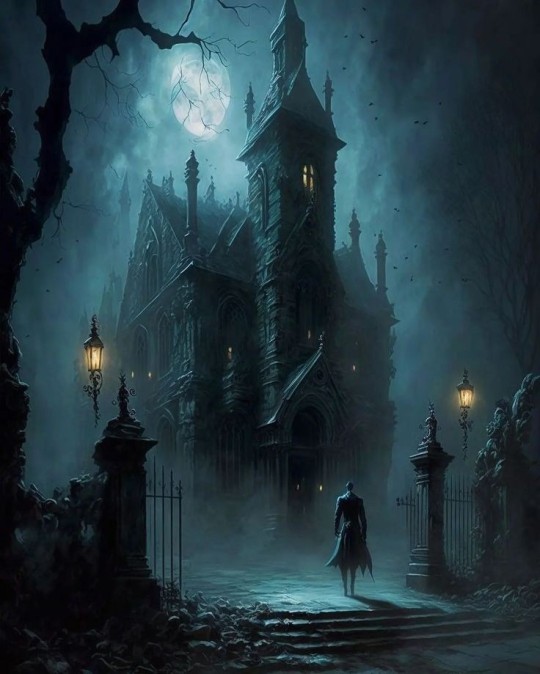
="[ NÃO BEM PINÓQUIO , Henrique , o Boneco de Madeira , Antes de sua Convergência Após Regresso -: Arcano 22 do Tarô , em CHYREN ]"=
" NÁSTRÖND , a Praia dos Corpos ou Cadáveres 🏖️..., no Reino Sombrio e Obscuro Regido por Detrás dos Véus do Grande Desconhecido ... , como que Metaforicamente em " Outra Dimensão " , no Onde Reina Aquela, a Grande Rainha , que os Antigos Germânicos a Chamam de HEL... , uma das Várias Vertências do Reino Escuro 🌑...,
em um Outro Onde por Detrás desta Terra e Conexões com o Exterior da Terra 🌎🌍 , e com...,
🌈 o Além Inimaginável...,
Ali Onde Há um Grande Salão Maligno Ante Garmr , o Devorador Voraz e Amável Cãozinho da Rainha HEL...,
Onda do Grande Salão Maligno , suas Portas estão em Direção ao Norte ...,
de Onde Serpentes 🐍 Segregam e Cospem Veneno em Abundância , para Gerarem Rios 🏞️ de Veneno...,
nos quais Afogam a Alma dos Condenados...,
para Serem Dispersados pelo Venerável NÍÖHÖGGR...,
O Devorador de Almas , Também Chamado " Mordedor Terrível...",
o Dragão , Servo da Rainha HEL...,
que Agarra e Carrega os Mortos Sob suas Asas...,
e que Habita o NIDAVELLIR , Os Vales Negros...,
Regidos por HEL , Também Chamada HELLA , e do mesmo modo , HELLIA , " MORTE QUE VISLUMBRA ESCONDIDA...,
Onde RATATOSKR , um Monstro que Sob Camuflagem e Ilusões , se faz parecer com um Esquilo 🐿️ , mas é Outro por Detrás de sua Forjada Aparência , dá o Imundo que é próprio dos Condenados de Volta para Eles...,
Ante o Magistral HELHEIMR , uma Vertência do Inferno : Infernum...,
Habitando Sob Este , no Outro Reino , o do Caos Cosmogônico ,
o Mundo Sombrio , Sinistro e Obscuro das Névoas , o NIFLHEIMR 🖤 (...)❗❗❗ "
https://www.linkedin.com/posts/luiz-henrique-souza-aranha-132113242_n%C3%A1str%C3%B6nd-a-praia-dos-corpos-ou-cad%C3%A1veres-activity-7303607893851832320-lTj0?utm_source=share&utm_medium=member_android&rcm=ACoAADwsUfYBtXgsUtMaizWWTWDkTye7Qk6QmV0
1 note
·
View note